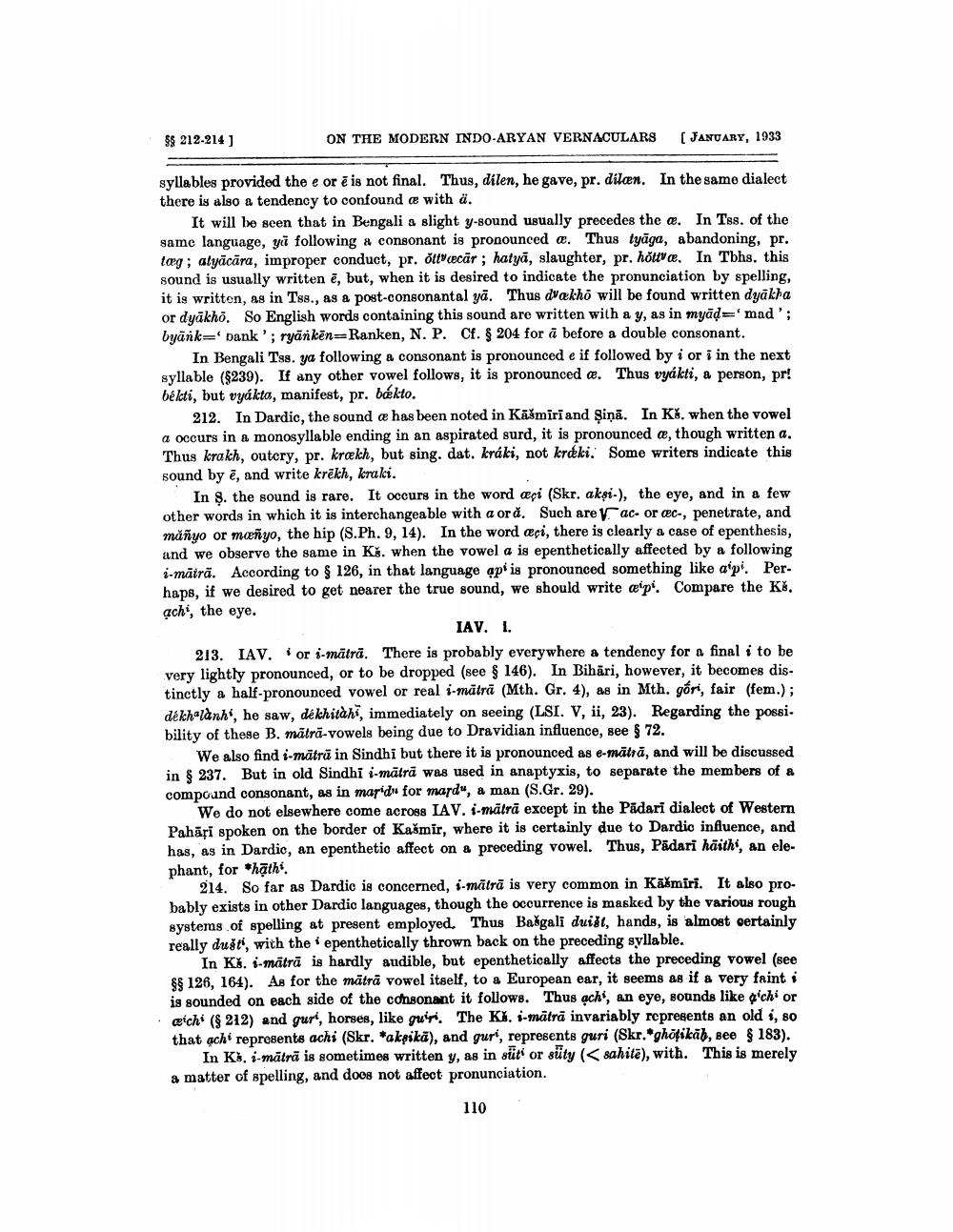________________
$$ 212-214 ]
ON THE MODERN INDO-ARYAN VERNACULARS
(JANUARY, 1933
syllables provided the e or é is not final. Thus, dilen, he gave, pr. dilan. In the same dialect there is also a tendency to confound & with ä.
It will be seen that in Bengali a slight y-sound usually precedes the æ. In Tss. of the same language, yu following a consonant is pronounced æ. Thus tyāga, abandoning, pr. tæg; atyācāra, improper conduct, pr. ott cecār; hatyā, slaughter, pr. holvæ. In Tbhs, this sound is usually written ē, but, when it is desired to indicate the pronunciation by spelling, it is writton, as in Tss., as a post-consonantal yā. Thus dvakho will be found written dyākha or dyākho. So English words containing this sound are written with a y, as in myāds' mad'; byānk='bank'; ryānkēn=Ranken, N. P. Cf. $ 204 for å before a double consonant.
In Bengali Tss. ya following a consonant is pronounced e if followed by i ori in the next syllable ($239). If any other vowel follows, it is pronounced c. Thus vyákti, a person, pr! béleti, but vyákta, manifest, pr. bekto.
212. In Dardic, the sound æ has been noted in Kāšmiri and şiņā. In K. when the vowel a occurs in a monosyllable ending in an aspirated surd, it is pronounced æ, though written a. Thus krakh, outcry, pr. krækh, but sing. dat. kráki, not kroki. Some writers indicate this sound by ē, and write krēkh, kraki.
In $. the sound is rare. It occurs in the word æçi (Skr, aksi-), the eye, and in a few other words in which it is interchangeable with a oră. Such are ac or @c-, penetrate, and mányo or mænyo, the hip (S.Ph. 9, 14). In the word açi, there is clearly a case of epenthesis, and we observe the same in Kš. when the vowel a is epenthetically affected by a following i-mätrā. According to $ 126, in that language api is pronounced something like a pi. Perhaps, if we desired to get nearer the true sound, we should write api. Compare the Kš. ach', the eye.
IAV. I. 213. IAV. or i-mātrā. There is probably everywhere a tendency for a final i to be very lightly pronounced, or to be dropped (see § 146). In Bihari, however, it becomes distinctly a half-pronounced vowel or real i-mātrā (Mth. Gr. 4), as in Mth. gori, fair (fem.): dakhalành, he saw, dekhitahi, immediately on seeing (LSI. V, ii, 23). Regarding the possi. bility of these B. mätra-vowels being due to Dravidian influence, see $ 72.
We also find i-mätrü in Sindhi but there it is pronounced as e-mātrā, and will be discussed in $ 237. But in old Sindhi i-mātrā was used in anaptyxis, to separate the members of a compound consonant, as in marid" for mard", a man (S.Gr. 29).
We do not elsewhere come across IAV. i-matrā except in the Padari dialect of Western Pahāri spoken on the border of Kašmir, where it is certainly due to Dardio influence, and has, as in Dardio, an epenthetio affect on a preceding vowel. Thus, Pädari häith, an ele. phant, for *hạth.
214. So far as Dardic is concerned, i-mitrā is very common in Kāšmiri. It also probably exists in other Dardic languages, though the occurrence is masked by the various rough systems of spelling at present employed. Thus Bažgali duidt, hands, is almost certainly really dušt', with the epenthetically thrown back on the preceding syllable.
In Kš. s-matrā is hardly audible, but epenthetically affects the preceding vowel (see $$ 126, 164). As for the mātrā vowel itself, to a European ear, it seems as if a very faint i is sounded on each side of the consonant it follows. Thus ach', an eye, sounds like a chi or æichi ( 212) and gur', horses, like guiri. The Kt. s-mātrā invariably represents an old i, so that achi represents achi (Skr. *akpika), and gur', represents guri (Skr. ghöfikāb, see & 183).
In K i-mātrā is sometimes written y, as in süt or süty ( sahitë), with. This is merely a matter of spelling, and does not affect pronunciation.
110




